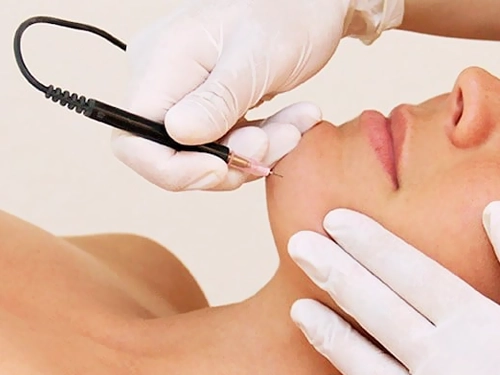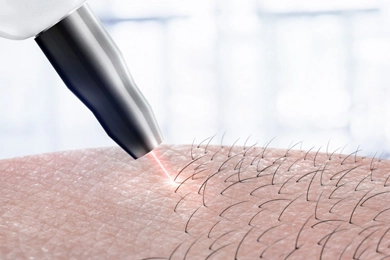
Unwanted hair can be a source of discomfort and self-consciousness for many. While there are numerous methods to get rid of it, electrolysis stands out as the only FDA-approved permanent hair removal technique. This comprehensive guide delves deep into the world of electrolysis, ensuring potential patients are well-informed and confident in their decisions.
Electrolysis is a hair removal technique that involves inserting a fine probe into the hair follicle and applying an electric current. This process destroys the hair growth center, ensuring that hair doesn't regrow in the treated area.
Electrolysis works by targeting the hair follicle, the root of the hair. When the probe delivers its electric current, it damages the follicle's growth center, preventing it from producing new hair. Over time, and with repeated treatments, hair in the treated areas becomes finer and eventually stops growing altogether.
There are three main types of electrolysis:
Electrolysis for Hair Removal, though widely recognized as a safe and effective method for permanent hair removal, does have potential side effects. It's crucial for individuals considering this treatment to be aware of these side effects, though they often tend to be temporary. Here are some potential side effects of electrolysis for hair removal:
It's worth noting that the severity and duration of side effects can vary based on individual factors, including skin type, area treated, and the skill of the electrologist. Proper aftercare and choosing an experienced and licensed practitioner can significantly minimize potential side effects. If any side effect seems prolonged or severe, it's essential to consult a dermatologist or the practicing electrologist.
The number of sessions required varies based on several factors: hair type, area of the body being treated, hormonal imbalances, etc. On average, patients might need between 15 to 30 sessions to see complete hair removal.
Before the Electrolysis for Hair Removal
After the Electrolysis for Hair Removal
While both electrolysis and laser hair removal offer long-term solutions to unwanted hair, they have key differences:
Effectiveness: Electrolysis is effective on all skin and hair types, while laser hair removal works best on individuals with light skin and dark hair.
Permanency: Electrolysis offers permanent hair removal, while laser hair removal reduces hair growth.
Procedure Time: Laser hair removal can treat larger areas faster, whereas electrolysis might take longer, especially for extensive areas.
Anyone looking for a permanent solution to unwanted hair is a potential candidate for electrolysis. However, it's especially beneficial for those who:
It's crucial to select a licensed and experienced electrologist. Ask for recommendations, read reviews, and schedule a consultation to discuss the procedure, costs, and expected results.
Electrolysis for Hair Removal stands out in the world of hair removal for its permanence and suitability for all skin and hair types. While it requires patience and multiple sessions, the results are unparalleled. As always, do thorough research and choose an experienced professional to ensure a safe and effective treatment. Through informed choices, patients can achieve the smooth, hair-free skin they desire, bolstering their confidence and well-being.
What is electrolysis for hair removal?
The hair follicle is damaged by electric currents during the FDA-approved permanent hair removal procedure known as electrolysis.
How does electrolysis work?
The hair growing tissue is destroyed by applying a small amount of electrical current after a very fine needle has been introduced into the hair follicle.
Is electrolysis permanent?
Since electrolysis targets the hair follicle, it can remove hair permanently when done properly.
How many sessions will I need?
Since hair growth cycles vary, multiple treatments are typically necessary to get the results you want. The area being treated and individual circumstances will affect how many sessions are needed.
Is electrolysis painful?
An extremely mild stinging or tingling sensation may be felt by patients. The degree of pain varies based on the person and the location being treated.
What areas of the body can be treated with electrolysis?
The face, brows, neck, breast, belly, bikini line, legs, back, and nearly any other place.
How long does each session last?
Depending on the region being treated, sessions might last anywhere from 15 minutes to an hour.
How is electrolysis different from laser hair removal?
While both techniques aim to destroy the hair follicle, electrolysis can treat all hair and skin types while laser hair removal employs light energy and is frequently better for larger regions.
Is electrolysis safe for all skin types?
Yes, electrolysis' appropriateness for people of all skin and hair colors is one of its benefits.
Are there any side effects to electrolysis?
Temporary redness, swelling, and the potential for small scabs are a few common side effects. Most go away in a few days.
How should I prepare for an electrolysis session?
For a few weeks before to your appointment, refrain from tanning, waxing, or hair removal in the treatment region.
Can men undergo electrolysis?
Without a doubt! Men frequently utilize electrolysis on their cheeks, backs, and brows.
Is electrolysis safe during pregnancy?
While electrolysis is often safe, it is advised that you speak with your doctor before having the process done while pregnant.
How soon will I see results?
While some results could be noticeable after the first session, further sessions are necessary for complete, long-lasting outcomes.
How does electrolysis compare in cost to other hair removal methods?
In contrast to temporary techniques, electrolysis can be more cost-effective in the long run while initially appearing to be more expensive.
Can I shave between electrolysis sessions?
Shaving is okay, but stay away from waxing and plucking because they remove hair from the follicle.
Why do I need multiple sessions when hair is removed during the first session?
The cycles of hair growth include growth, rest, and transition. Multiple sessions make sure that all hair is treated while it is still growing.
What's the history of electrolysis?
One of the earliest techniques for permanent hair removal is electrolysis, which has been in use for more than a century.
After having my face electrolyzed, may I wear makeup?
In order to prevent skin sensitivity, it is essential to wait at least 24 hours before putting makeup.
Are there any risks associated with electrolysis?
Risks are minimized when done by a qualified and experienced professional. But possible hazards include infection, skin discoloration, and scarring.
How do I choose a qualified electrologist?
Find a licensed professional that has a solid reputation, certifications, and ideally a consultation to go through your needs.
Why choose electrolysis over temporary hair removal methods?
With electrolysis, there is no longer a need for regular treatments or the accompanying costs of short-term solutions.
How long should I wait between sessions?
The answer is that sessions are often separated by 1-2 weeks at first, increasing throughout the course of treatment.
Is electrolysis suitable for teens?
Yes, with parental permission. It offers kids who might feel self-conscious about unwanted hair a remedy.
Will there be scarring from electrolysis?
When electrolysis is done properly and aftercare instructions are followed, scarring is extremely uncommon.
How do I care for the treated area post-session?
Keep the area tidy, stay out of the sun, and resist the impulse to pick or scratch.
Are there any medications or conditions that may affect electrolysis treatment?
The skin may become more sensitive as a result of some treatments and medical disorders. The electrologist must be informed of your medical history.
What's the difference between thermolysis, galvanic, and blend electrolysis methods?
The mix method combines the two. Galvanic involves a chemical reaction; thermolysis uses heat. Your doctor can give you advice on the most effective approach.
Can electrolysis cause ingrown hairs?
No, it's actually a remedy for ingrown hairs that already exist.
Why might I feel a tingling sensation post-treatment?
The electric current utilized during the treatment may be the cause of this, however it normally goes away shortly.
Can I undergo electrolysis if I have tattoos?
Yes, however you must let the doctor know because you need to take extra precautions around tattooed regions.
How do I know if electrolysis is right for me?
Based on your hair type, skin type, and hair removal goals, a consultation with a licensed electrologist can help establish if you're a good candidate.
What technology is used in modern electrolysis devices?
In comparison to older machines, modern gadgets offer greater comfort, flexible settings, and improved precision.
Can electrolysis treat white or gray hair?
Yes, electrolysis can treat hair of any color, even white hair, unlike laser hair removal.
How long after electrolysis can I exercise?
To avoid sweating and potential irritation of the treated area, it is advised to wait at least 24 to 48 hours before indulging in severe exercise.
Can electrolysis be used on sensitive areas like the bikini line and nipples?
Without a doubt! Most body parts, including those that are sensitive, can be safely treated with electrolysis when done with the right technique and settings.
How is the hair's thickness or coarseness a factor in the treatment?
However, electrolysis works for all hair types and may need more sessions to treat coarser hairs adequately.
What is the difference between electrolysis and depilatory creams or shaving?
The answer is that shaving and depilatory lotions only remove hair temporarily from the surface. The hair follicle is the goal of electrolysis, which provides a long-lasting remedy.
Will electrolysis cause hyperpigmentation or skin discoloration in me?
The risk of transient hyperpigmentation is minimal, especially for people with darker skin tones. This risk can be reduced by wearing sunscreen and avoiding direct sun exposure.
Can those who suffer from eczema or psoriasis have electrolysis?
Consultations with an expert electrologist and dermatologist are essential. Although the technique can be done, it may be necessary to avoid flare-ups or active lesions in the treatment area.
Keep in mind that electrolysis provides a long-lasting remedy for excessive hair growth. To ensure efficient and secure outcomes while thinking about this procedure, do your research and choose a reliable, licensed electrologist.
 Everything About Male Laser Hair Removal
Everything About Male Laser Hair RemovalIn recent times, men who are looking for a long-term solution to undesirable body hair have grown more and more interested in laser hair removal. Read More...
 Laser Hair Removal vs. Electrolysis: Which is Right for You?
Laser Hair Removal vs. Electrolysis: Which is Right for You?Two popular techniques—Laser Hair Removal and Electrolysis—have emerged as front-runners in the race for smooth, hair-free skin. Read More...
 Differences Between Electrolysis and Laser Hair Removal
Differences Between Electrolysis and Laser Hair RemovalWhen considering permanent hair removal solutions, two methods dominate the industry: electrolysis and laser hair removal. Read More...
 What Factors Affect Laser Hair Removal Prices?
What Factors Affect Laser Hair Removal Prices?The cost of treatment of laser hair removal may increase for clinics located in affluent or cosmopolitan areas due to higher operational expenses such as rent, utilities, and salaries. Read More...
 Acne After Laser Hair Removal And Its Treatment
Acne After Laser Hair Removal And Its TreatmentUnwanted hair can be removed from various parts of the body using the popular and efficient laser hair removal procedure. It provides a long-lasting method to stop hair growth, leaving skin that is smooth an Read More...
 Medications You Should Avoid While Receiving Laser Hair Removal
Medications You Should Avoid While Receiving Laser Hair RemovalUsing a laser to eliminate unwanted body hair is a common cosmetic technique known as laser hair removal. Many people elect to undergo laser hair removal in order to obtain a smoother, hair-free appearance b Read More...